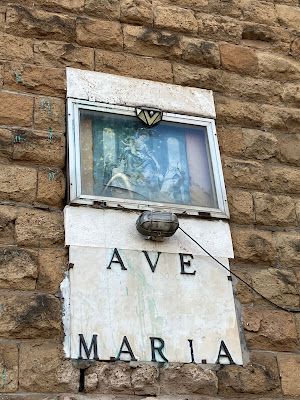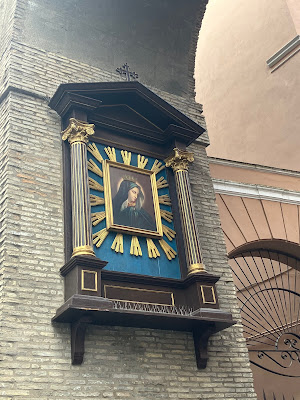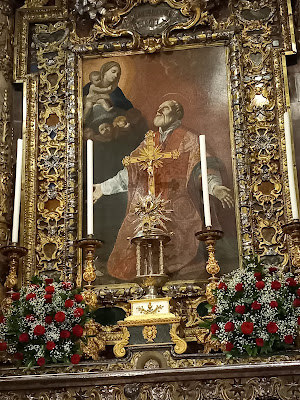Madonna del Rosario in Circonvallazione Gianicolense
Santa Maria in Portico in Via di Sant'Ambrogio
"The Star of David" di AleXsandro Palombo
Anti-Semitism, History Repeating di AleXsandro Palombo
Quinzi e Gabrieli
Targa in memoria del restauro dell'affresco del Cristo Crocefisso con la Vergine e San Gregorio Magno
Madonna del Dito in Vicolo d'Orfeo
Какво е било знамето на Римската империя?
Но орелът, макар и признат символ на Рим и на единството между римляните, който украсяваше както стълбовете, така и многобройните паметници и монети, не се появи в уникален флаг на Римската империя. Същото може да се каже и за друг символ на Рим, писмеността SPQR (Senatus PopulusQue Romanus), която, въпреки че е свързана с Републиката, е била широко използвана по време на Империята: тези четири букви представляват Рим, но не са включени в уникален флаг.
Друг елемент, който по някакъв начин изпълнява функциите на съвременните национални знамена, символизиращи единството на всички поданици на Римската империя, е ликът на управляващия император. Императорът всъщност до окончателното християнизиране на империята също представлява божество и неговият образ се появява във всички провинции, както и върху безброй монети, които се разпространяват надлъж и нашир. Сред многобройните изображения, достигнали до нас, има свидетелства дори за торти с изображението на императора, отпечатано върху тях.Прогресивното християнизиране на Римската империя води до въвеждането на християнски символи и в този смисъл историята на Константин и битката при Милвийския мост е емблематична, според която императорът, преди битката срещу съперника си Максенций през 312 г., имал видение на кръст и надпис ἐν τούτῳ νίκα, преведено на латински като „In hoc signo vinces“, или „с този знак ще победиш“, което го кара да вмъкне христограмата, съставена от гръцките букви chi и rho в своя лабарум, факт, който според традицията би бил решаващ за победата. Този лабарум се появява на различни монети от онова време, като христограмата е поставена както на върха на мачтата, така и върху знамето, и скоро става широко разпространена сред императорските изображения. Според Живота на Константин от Евсевий от Кесария (който е бил близък сътрудник на императора), оригиналният лабарум на императора включва както кръст с Хи-Ро, така и портрет на Константин, което показва важността на портрета на императора в регалиите на времето.
През следващите векове императорските регалии се отличават с нарастващо присъствие на религиозни символи и са необходими векове, след падането на Западната Римска империя, за Източната Римска империя (често наричана условно Византийска империя) и Свещената Римска империя да започнат да приемат национално знаме в съвременния смисъл на термина, което води до Късното средновековие, период, в който много държавни образувания започват този процес.
Clivo delle Mura Vaticane
Edicola Sacra di Sant'Antonio Abate in Via Aurelia
Il Qudrifoglio
Largo Cardinale Agostino Galamini
Cili ishte flamuri i Perandorisë Romake?
Mbi dy mijë vjet pas themelimit të saj, Perandoria Romake është një nga realitetet historike më të studiuara, që tërheq punën e studiuesve dhe vëmendjen e entuziastëve dhe kureshtarëve, por aq më tepër në dritën e kësaj vëmendjeje, një pyetje që shumëkush shtron është: cili ishte flamuri i Perandorisë Romake? Perandoria Romake u themelua në vitin 27 para Krishtit, ajo mbeti një entitet i vetëm deri në një federalizim gradual dhe ndarjen përfundimtare midis Lindjes dhe Perëndimit në vitin 395 pas Krishtit, pas së cilës të dy Perandoritë morën rrugë të ndryshme: ajo perëndimore ra në 476, ajo lindore në 1453 me rënien e Konstandinopojës, ndërsa që nga viti 80 Imperii i Perandorisë Romake. gjithashtu ishte në gjendje të pretendonte trashëgimi me atë Perandori. Kohë të ndryshme, epoka të ndryshme dhe gjithashtu vende të ndryshme, në të cilat roli i flamurit ka qenë gjithmonë i ndryshëm.
Por në origjinën e saj, kur lindi Perandoria Romake dhe në shekujt e parë të ekzistencës së saj, para ndarjes, a kishte një flamur? Dy mijë vjet më parë, shumë përpara formimit të shteteve moderne kombëtare, flamuri kishte një funksion krejtësisht të ndryshëm, veçanërisht për të dalluar një ushtri në luftë. Ky funksion përmbushej nga shenjat e Legjioneve, të cilat u çuan në betejë nga ushtarë specialë të quajtur signifer dhe vexillifer. Këto shenja, përveç emrave dhe simboleve të Legjioneve, shpesh përshkruanin kafshë që përfaqësonin simbole të forcës dhe të cilat ishin huazuar nga shenjat e epokës republikane. Midis këtyre simboleve ata mbanin edhe Shqiponjën, një simbol shumë i rëndësishëm ndër ushtarakët dhe i lidhur me Jupiterin, prania e të cilit në të gjitha provincat e Perandorisë kontribuoi për ta bërë atë një nga simbolet e fuqisë së Romës dhe të unitetit midis romakëve. Ky imazh shpesh zbukuronte shtyllat e standardeve dhe ushtari që e mbante quhej akuilifer. Banderolat ishin gjithashtu të kuqe, një referencë për perëndinë romake të luftës Marsin: e kuqja mbeti një ngjyrë e lidhur me pankarta të tilla.
Por Shqiponja, ndonëse një simbol i njohur i Romës dhe i unitetit midis romakëve, që dekoronte si polet, ashtu edhe monumentet dhe monedhat e shumta, nuk u shfaq në një flamur unik të Perandorisë Romake. E njëjta gjë mund të thuhet për një tjetër simbol të Romës, shkrimin SPQR (Senatus PopulusQue Romanus), i cili edhe pse i lidhur me Republikën përdorej gjerësisht nën Perandorinë: këto katër shkronja përfaqësonin Romën, por nuk përfshiheshin në një flamur unik.
Një element tjetër që në një farë mënyre kryente funksionet e flamujve kombëtarë modernë, duke simbolizuar unitetin e të gjithë nënshtetasve të Perandorisë Romake, ishte shëmbëlltyra e Perandorit në fuqi. Perandori, në fakt, deri në kristianizimin përfundimtar të Perandorisë përfaqësonte gjithashtu një hyjni dhe imazhi i tij u shfaq në të gjitha provincat, si dhe në një mori monedhash që përhapeshin shumë e gjerë. Ndër imazhet e shumta që na kanë ardhur, ka edhe dëshmi të ëmbëlsirave me imazhin e Perandorit të shtypur në to.Krishterimi progresiv i Perandorisë Romake solli futjen e simboleve të krishtera dhe në këtë kuptim historia e Kostandinit dhe beteja e urës së Milvianit është emblematike, sipas së cilës Perandori, para betejës kundër rivalit të tij Maxentius në vitin 312, kishte një vizion të një kryqi dhe shkrimin ἐν τούτῳ "në këtë shenjë "në këtë shenjë "nίκα", e përkthyer në latinisht, "në këtë shenjë" win”, çka e shtyu të fuste në labarumin e tij kristografinë e përbërë nga shkronjat greke chi dhe rho, fakt që sipas traditës do të kishte qenë vendimtar për fitoren. Ky labarum shfaqet në monedha të ndryshme të kohës, me kristogramin e vendosur si në majë të direkut ashtu edhe në flamur, dhe shumë shpejt u përhap në imazhet perandorake. Sipas Jetës së Kostandinit nga Eusebius i Cezaresë (i cili ishte një bashkëpunëtor i ngushtë i Perandorit), labarumi origjinal i Perandorit përmbante një kryq me Chi-Rho dhe një portret të Kostandinit, duke demonstruar rëndësinë e portretit të perandorit në regalitë e kohës.
Në shekujt në vijim, regalia perandorake shfaqi një prani në rritje të simboleve fetare dhe u deshën shekuj, pas rënies së Perandorisë Romake Perëndimore, që Perandoria Romake e Lindjes (shpesh e quajtur zakonisht Perandoria Bizantine) dhe Perandoria e Shenjtë Romake të fillonin të adoptonin një flamur kombëtar në kuptimin modern të termit, duke çuar në periudhën e vonë të Mesjetës së Mesme.
מה היה דגל האימפריה הרומית
אבל הנשר, למרות שהוא סמל מוכר של רומא ושל האחדות בין הרומאים, שקישט גם את העמודים וגם את המונומנטים והמטבעות הרבים, לא הופיע בדגל ייחודי של האימפריה הרומית. ניתן לומר את אותו הדבר על סמל נוסף של רומא, הכתובת SPQR (Senatus PopulusQue Romanus), שלמרות שהיה קשור לרפובליקה היה בשימוש נרחב תחת האימפריה: ארבע האותיות הללו ייצגו את רומא, אך לא נכללו בדגל ייחודי.
מרכיב נוסף שביצע בדרך כלשהי את תפקידיהם של דגלי לאום מודרניים, המסמלים את אחדותם של כל נתיני האימפריה הרומית, היה דמותו של הקיסר השולט. הקיסר, למעשה, עד להתנצרות המוחלטת של האימפריה ייצג גם אלוהות, ודמותו הופיעה בכל המחוזות, כמו גם על אינספור מטבעות שהתפשטו למרחקים. בין התמונות הרבות שהגיעו אלינו יש אפילו עדויות לעוגות שעליהן מודפסת דמות הקיסר.
במאות הבאות, הסמלים הקיסריים הופיעו נוכחות גוברת של סמלים דתיים, וחלפו מאות שנים, לאחר נפילת האימפריה הרומית המערבית, עד שהאימפריה הרומית המזרחית (שנקראת בדרך כלל האימפריה הביזנטית) והאימפריה הרומית הקדושה החלו לאמץ דגל לאומי במובן המודרני של המונח, שהובילו לתהליך זה במדינות ארצות הברית.
Ποια ήταν η σημαία της Ρωμαϊκής Αυτοκρατορίας;
Πάνω από δύο χιλιάδες χρόνια μετά την ίδρυσή της, η Ρωμαϊκή Αυτοκρατορία είναι μια από τις πιο μελετημένες ιστορικές πραγματικότητες, προσελκύοντας το έργο των μελετητών και την προσοχή των ενθουσιωδών και των περίεργων, αλλά ακόμη περισσότερο υπό το φως αυτής της προσοχής, ένα ερώτημα που πολλοί θέτουν είναι: ποια ήταν η σημαία της Ρωμαϊκής Αυτοκρατορίας;
Η Ρωμαϊκή Αυτοκρατορία ιδρύθηκε το 27 π.Χ. και παρέμεινε μια ενιαία οντότητα μέχρι τη σταδιακή ομοσπονδία και την οριστική διαίρεση μεταξύ Ανατολής και Δύσης το 395 μ.Χ., μετά την οποία οι δύο αυτοκρατορίες ακολούθησαν διαφορετικούς δρόμους: η δυτική έπεσε το 476, η ανατολική το 1453 με την άλωση της Κωνσταντινούπολης, ενώ από το έτος 800 ήταν επίσης το Imperii, το Ρωμαϊκό. ικανός να διεκδικήσει τη διαδοχή με εκείνη την Αυτοκρατορία. Διαφορετικές εποχές, διαφορετικές εποχές ακόμα και διαφορετικά μέρη, στα οποία ο ρόλος της σημαίας ήταν πάντα διαφορετικός.
Αλλά ο αετός, αν και αναγνωρισμένο σύμβολο της Ρώμης και της ενότητας μεταξύ των Ρωμαίων, που διακοσμούσε τόσο τις σημαίες όσο και πολλά μνημεία και νομίσματα, δεν εμφανίστηκε σε μια μοναδική σημαία της Ρωμαϊκής Αυτοκρατορίας. Το ίδιο μπορεί να ειπωθεί για ένα άλλο σύμβολο της Ρώμης, τη γραφή SPQR (Senatus PopulusQue Romanus), η οποία αν και συνδέθηκε με τη Δημοκρατία χρησιμοποιήθηκε ευρέως υπό την Αυτοκρατορία: αυτά τα τέσσερα γράμματα αντιπροσώπευαν τη Ρώμη, αλλά δεν περιλαμβάνονταν σε μία μόνο σημαία.
Ένα άλλο στοιχείο που κατά κάποιο τρόπο εκπλήρωνε τις λειτουργίες των σύγχρονων εθνικών σημαιών, συμβολίζοντας την ενότητα όλων των υπηκόων της Ρωμαϊκής Αυτοκρατορίας, ήταν το ομοίωμα του βασιλεύοντος αυτοκράτορα. Μάλιστα, μέχρι τον οριστικό εκχριστιανισμό της Αυτοκρατορίας, ο Αυτοκράτορας αντιπροσώπευε επίσης μια θεότητα, και η εικόνα του εμφανιζόταν σε όλες τις επαρχίες, καθώς και σε μυριάδες νομίσματα που απλώνονταν παντού. Μεταξύ των πολυάριθμων εικόνων που έχουν φτάσει σε εμάς, υπάρχουν ακόμη και στοιχεία για κέικ με την εικόνα του Αυτοκράτορα τυπωμένη πάνω τους.
Στους επόμενους αιώνες, τα αυτοκρατορικά διακριτικά παρουσίαζαν αυξανόμενη παρουσία θρησκευτικών συμβόλων και χρειάστηκαν αιώνες, μετά την πτώση της Δυτικής Ρωμαϊκής Αυτοκρατορίας, για να αρχίσουν η Ανατολική Ρωμαϊκή Αυτοκρατορία (συχνά ονομάζεται Βυζαντινή Αυτοκρατορία) και η Αγία Ρωμαϊκή Αυτοκρατορία να υιοθετούν μια εθνική σημαία με τη σύγχρονη έννοια του όρου.
What was the flag of the Roman Empire?
Over two thousand years after its foundation, the Roman Empire is one of the most studied historical realities, which attracts the work of scholars and the attention of enthusiasts and the curious, but even more so in light of this attention, a question that many ask is: what was the flag of the Roman Empire? The Roman Empire was founded in 27 BC, it remained a single entity until a gradual federalization and the definitive division between East and West in 395 AD, after which the two Empires took different paths: the Western one fell in 476, the Eastern one in 1453 with the Fall of Constantinople, while since 800, the year of the Translatio Imperii, the Holy Roman Empire has also been able to claim succession with that Empire. Different times, different eras and also different places, in which the role of the flag has always been different.
But at its origins, when the Roman Empire was born, and in the first centuries of its existence, before its division, did it have a flag? Two thousand years ago, well before the formation of modern nation states, the flag had a completely different function, especially to distinguish an army at war. This function was fulfilled by the insignia of the Legions, which were carried into battle by special soldiers called signifer and vexillifer. These insignia, in addition to the names and symbols of the Legions, often depicted animals that represented symbols of strength and which were borrowed from the insignia of the Republican era. Among these symbols they also carried the Eagle, a very important symbol among the military and linked to Jupiter, whose presence in all the Provinces of the Empire contributed to making it one of the symbols of the power of Rome and of unity among the Romans. This image often decorated the poles of the standards and the soldier who carried it was called aquilifer. The banners were also red, a reference to the Roman god of war Mars: red remained a color associated with such banners.
But the Eagle, although a recognized symbol of Rome and of the unity among the Romans, which decorated both the poles and numerous monuments and coins, did not appear in a unique flag of the Roman Empire. The same can be said for another symbol of Rome, the writing SPQR (Senatus PopulusQue Romanus), which although linked to the Republic was widely used under the Empire: these four letters represented Rome, but were not included in a unique flag.
Another element that in some way performed the functions of modern national flags, symbolizing the unity of all the subjects of the Roman Empire, was the effigy of the reigning Emperor. The Emperor, in fact, until the definitive Christianization of the Empire also represented a divinity, and his image appeared in all the provinces, as well as on myriads of coins that spread far and wide. Among the numerous images that have come down to us there is even evidence of cakes with the image of the Emperor printed on them.The progressive Christianization of the Roman Empire brought about the introduction of Christian symbols, and in this sense the story of Constantine and the battle of the Milvian Bridge is emblematic, according to which the Emperor, before the battle against his rival Maxentius in 312, had a vision of a cross and the writing ἐν τούτῳ νίκα, translated into Latin as "In hoc signo vinces", or "with this sign you will win", which led him to insert the Christogram composed of the Greek letters chi and rho in his labarum, a fact that according to tradition would have been decisive for victory. This labarum appears on various coins of the time, with the Christogram placed both at the top of the mast and on the flag, and soon became widespread among the Imperial images. According to the Life of Constantine by Eusebius of Caesarea (who was a close associate of the Emperor), the Emperor's original labarum featured both a cross with the Chi-Rho and a portrait of Constantine, demonstrating the importance of the emperor's portrait in the regalia of the time.
In the following centuries, the imperial regalia featured an increasing presence of religious symbols, and it took centuries, after the fall of the Western Roman Empire, for the Eastern Roman Empire (often conventionally called the Byzantine Empire) and the Holy Roman Empire to begin adopting a national flag in the modern sense of the term, leading to the Late Middle Ages, a period in which many state entities began this process.
Qual era la bandiera dell'Impero Romano?
Madonna della Seggiola in Vicolo delle Palline
Cappella di San Filippo Neri nella Chiesa di Santa Maria in Vallicella
Fu costruita tra il 1600 e il 1606 dal Fiorentino Neri del Nero su progetto di Onorio Longhi, con pianta circolare, destinata ad ospitare le spoglie del Santo.











.svg.png)












